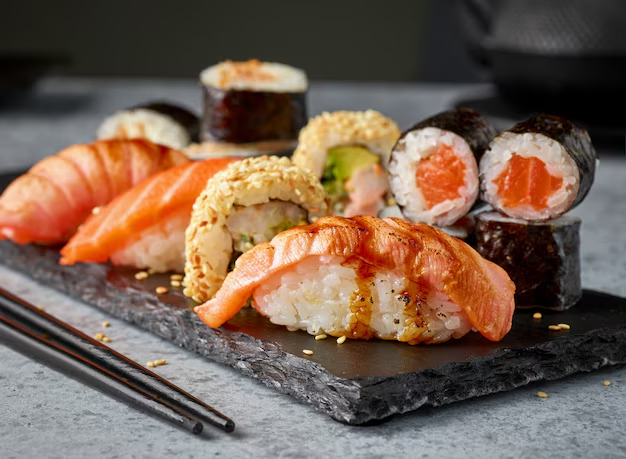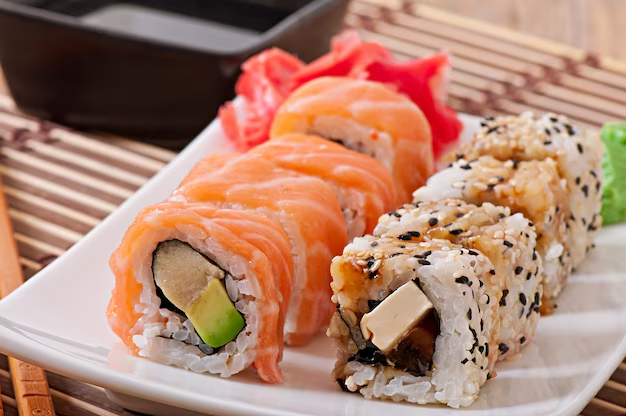Sushi, a traditional Japanese dish, has become a global phenomenon, adored for its unique flavors, artistic presentation, and versatility. From high-end restaurants to convenient supermarket trays, sushi’s presence in global cuisine is undeniable. But aside from its aesthetic appeal, many wonder: is sushi healthy? Let’s explore the health benefits, nutrients, and calorie content of this popular dish to determine how it fits into a balanced diet.
What Are Sushi Nutrients?
Sushi is more than just a flavorful indulgence; it’s a nutrient powerhouse. Its combination of ingredients provides essential nutrients that support overall health. Here’s a breakdown of the key sushi nutrients that make it a favorite among health-conscious eaters:
1. Protein
Sushi often features fish like tuna, salmon, and mackerel, which are excellent sources of high-quality protein. Protein is essential for muscle repair, growth, and maintaining a healthy immune system. Even vegetarian sushi rolls include protein-rich ingredients like tofu or eggs.
2. Omega-3 Fatty Acids
Fish used in sushi, especially fatty varieties like salmon and mackerel, are packed with omega-3 fatty acids. These essential fats promote heart health, reduce inflammation, and support brain function.
3. Fiber
Seaweed wraps (nori) and added vegetables like cucumber, avocado, and carrots contribute dietary fiber. Fiber aids digestion, regulates blood sugar levels, and keeps you feeling full longer.
4. Vitamins and Minerals
- Vitamin D: Found in oily fish, helps maintain strong bones and supports the immune system.
- Iodine: Seaweed is a natural source of iodine, essential for thyroid function.
- Vitamin A and C: Vegetables in sushi rolls add antioxidants that protect cells and enhance skin health.
- Iron and Zinc: These minerals in fish and seaweed help support energy production and immunity.
5. Low in Saturated Fat
Sushi generally avoids heavy fats, using healthier fats from fish and avocado. This makes it a lighter option compared to many Western dishes.
Healthiest Sushi Rolls

Not all sushi rolls are created equal. While some are packed with nutrients, others can be calorie-dense and loaded with sauces. Here are some of the healthiest sushi rolls to keep on your radar:
1. Salmon Avocado Roll
This roll combines the omega-3 richness of salmon with the heart-healthy fats of avocado, making it a perfect nutrient-dense choice.
2. Cucumber Roll (Kappa Maki)
Simple yet satisfying, this roll is low in calories and packed with hydration and fiber from cucumbers.
3. Tuna Roll
Lean and packed with protein, the tuna roll is a great option for those looking to keep it light while getting a boost of essential amino acids.
4. Veggie Roll
Filled with a variety of fresh vegetables like carrots, avocado, and cucumber, veggie rolls are high in fiber and vitamins while keeping calorie counts low.
5. Rainbow Roll
This colorful option includes a mix of different fish and vegetables, offering a variety of nutrients in one delicious package.
What to Avoid
For a healthier choice, avoid rolls with:
- Fried components (e.g., tempura rolls)
- Heavy sauces like mayonnaise-based spicy toppings or cream cheese
- Excessive soy sauce, which can be high in sodium
Is sushi low calorie? Yes, many rolls are. However, it depends on the ingredients used and portion size.
To Read:Is Pasta Bad for Weight Loss? A Detailed Guide
Sushi and Weight Loss
If you’re on a weight loss journey, sushi can be a valuable ally. But is sushi healthy for weight loss, and can it fit into your calorie goals? Absolutely—with a few considerations.
1. Low-Calorie Options
Many sushi rolls are naturally low in calories. For example:
- A cucumber roll contains about 136 calories.
- A salmon roll has roughly 231 calories. This makes sushi a better choice compared to higher-calorie meals like burgers or pasta dishes.
2. Balanced Ingredients
Focus on rolls made with lean fish, fresh vegetables, and minimal rice. Brown rice is a great alternative for added fiber and a lower glycemic impact.
3. Portion Control
While sushi is light, overindulging can add up quickly, especially with rolls that have extra toppings or fried components. Opt for smaller portions or sashimi (just fish slices) to reduce calorie intake.
4. Comparisons to Other Meals
Compared to fast food or heavy restaurant meals, sushi stands out for its nutrient density and lighter calorie load. It offers a satisfying way to enjoy flavors without overindulging.
So, is sushi good for weight loss? Absolutely, if you make mindful choices and keep an eye on portion sizes.
Sushi and Calories
Understanding sushi calories is key to enjoying it as part of a healthy diet. Here’s a breakdown of common sushi rolls and their approximate calorie counts:
| Sushi Type | Calories Per Roll (6 pieces) |
| Cucumber Roll | 136 |
| Avocado Roll | 140 |
| Tuna Roll | 184 |
| Salmon Avocado Roll | 231 |
| Spicy Tuna Roll | 290 |
| California Roll | 250 |
| Tempura Shrimp Roll | 508 |
Factors Influencing Calories
- Rice Quantity: Rolls with a large amount of rice have higher calories. Brown rice adds more fiber but can slightly increase calories.
- Sauces and Fillings: Creamy or spicy sauces, as well as tempura fillings, significantly increase calorie counts.
- Serving Style: Nigiri (fish over a small rice ball) and sashimi (fish only) are lower in calories compared to maki rolls.
Is Sushi Fattening?
Sushi isn’t inherently fattening, but high-calorie options and overeating can contribute to weight gain. Stick to lean fish, veggie rolls, or sashimi to keep calories in check.
Sushi as a Balanced Meal
Sushi can be both indulgent and healthy. Pair it with miso soup or a seaweed salad for a satisfying, nutrient-rich meal.
Is Sushi Raw Fish?
A common misconception is that sushi always includes raw fish. While many sushi types do feature raw fish, sushi itself refers to vinegared rice paired with various toppings or fillings, which may or may not include raw fish. So, is sushi raw fish? Let’s break it down.

1. Types of Sushi Featuring Raw Fish
Raw fish is often found in:
- Sashimi: Thinly sliced raw fish served without rice.
- Nigiri: A slice of raw fish atop a small ball of vinegared rice.
- Specialty Rolls: Many rolls include raw fish like tuna, salmon, or yellowtail as a key ingredient.
Raw fish provides a wealth of omega-3 fatty acids, which are vital for heart and brain health. Additionally, consuming fresh, high-quality raw fish can enhance the authentic sushi experience.
2. Cooked Sushi Options
If raw fish isn’t appealing, don’t worry—not all sushi is raw. Cooked alternatives include:
- Tempura Rolls: Fried fish or vegetables wrapped in rice and seaweed.
- California Rolls: Typically feature cooked imitation crab.
- Eel Sushi (Unagi): Includes cooked freshwater eel.
- Shrimp Nigiri: Often uses cooked shrimp.
3. Is Raw Sushi Good for You?
Raw sushi can be incredibly healthy if the fish is fresh, sustainably sourced, and prepared safely. Its omega-3 content promotes cardiovascular health, and it’s low in saturated fat. However, it’s essential to be cautious about foodborne illnesses and mercury levels in certain fish types. Pregnant individuals and those with weakened immune systems should opt for cooked sushi options.
Is Sushi Healthy for Diabetics?
For individuals with diabetes, the question often arises: is sushi healthy for diabetics? The answer lies in ingredient selection and portion control.
1. Glycemic Index of Sushi Ingredients
Sushi rice is traditionally made with white rice and sugar, which can raise blood sugar levels quickly. However, switching to brown rice can reduce the glycemic impact due to its higher fiber content.
2. Diabetic-Friendly Ingredients
- Avocado: A healthy fat source that helps stabilize blood sugar levels.
- Fish: High in protein and omega-3s, fish provides a low-carb option that doesn’t spike glucose levels.
- Vegetables: Ingredients like cucumber, seaweed, and bell peppers add fiber and nutrients without affecting blood sugar.
3. Tips for Diabetics
- Opt for sashimi or veggie rolls to avoid excess carbs.
- Pair sushi with a salad or miso soup to increase satiety without overloading on rice.
- Limit high-sodium soy sauce to prevent water retention and blood pressure spikes.
When chosen wisely, sushi can absolutely be part of a diabetic-friendly diet.
Sushi and Cholesterol
Sushi can either benefit or hinder cholesterol levels depending on the ingredients. Let’s explore the relationship between sushi and cholesterol.
1. Heart-Healthy Options
- Fish like salmon and tuna are rich in omega-3 fatty acids, which help raise HDL (good cholesterol) levels and lower LDL (bad cholesterol).
- Avocado also contributes heart-healthy monounsaturated fats.
2. Ingredients to Limit
- Fried components like tempura add trans fats, which can increase bad cholesterol.
- Creamy sauces and cheese, found in fusion rolls, can be high in saturated fats.
3. Is Sushi Good for High Cholesterol?
Yes, sushi can be good for managing cholesterol if you stick to simple rolls with raw fish, veggies, and minimal sauces. Combining sushi with healthy sides, like edamame or seaweed salad, enhances its cardiovascular benefits.
Is Vegetarian Sushi Healthy?
Vegetarian sushi is an excellent option for those seeking lighter, plant-based meals. But is veg sushi healthy? Absolutely—it’s a low-calorie, nutrient-packed choice.
1. Nutritional Benefits
- No Cholesterol: With no animal products, vegetarian sushi is cholesterol-free.
- Fiber-Rich: Veggie sushi often includes high-fiber ingredients like cucumber, avocado, and carrots, which aid digestion and promote satiety.
- Vitamin Boost: Seaweed and fresh vegetables deliver essential vitamins and minerals.
2. Popular Vegetarian Rolls
- Avocado Roll: High in healthy fats.
- Cucumber Roll: Hydrating and refreshing.
- Vegetable Tempura Roll: A crispy, satisfying option—though it’s best enjoyed in moderation due to its fried components.
Vegetarian sushi is not only healthy but also an inclusive option for people with dietary restrictions.
To Read: Seafood Stuffing Recipe
Specific Sushi Rolls and Their Health Benefits
Not all sushi rolls are created equal, so let’s evaluate the health profiles of some popular choices.
1. Is the California Roll Healthy?
California rolls typically contain imitation crab, avocado, and cucumber. While low in calories (around 250 per roll), the imitation crab is a processed food. Choosing rolls with fresh fish is a healthier alternative.
2. Spicy Tuna Roll
This roll offers the benefits of tuna’s high protein and omega-3 content. However, spicy mayo can add extra calories and saturated fat. Requesting the sauce on the side can make it healthier.
3. Dragon Roll
While delicious, dragon rolls often include tempura and heavy sauces, making them calorie-dense. Opt for simpler rolls to stay on track with health goals.
FAQ
Is sushi healthy to eat every day?
Eating sushi every day can be healthy if you choose low-calorie, nutrient-rich options. Focus on fish like salmon and tuna, and balance with vegetables. However, be cautious about mercury levels in certain fish.
Is a sushi bowl healthy?
A sushi bowl can be a healthy option, especially when it includes lean fish, vegetables, and minimal added sauces. It’s often higher in vegetables and can be a lower-calorie alternative to sushi rolls.
Is sushi heart healthy?
Sushi, particularly when made with omega-3-rich fish like salmon, can support heart health. Opt for sushi with avocado and seaweed for added fiber and antioxidants, and avoid excess soy sauce to reduce sodium intake.
Is sushi with chicken healthy?
Sushi with chicken can be a healthy choice, providing lean protein. However, it’s important to choose grilled chicken over fried to keep calories low. Pair with vegetables to increase fiber and nutrition.
Conclusion
Sushi can be incredibly healthy when made with fresh, nutrient-dense ingredients like fish, vegetables, and avocado. It offers numerous benefits, including a high protein content, omega-3 fatty acids, and a variety of vitamins and minerals. However, the healthiness of sushi depends on your choices—lean towards simple rolls, sashimi, or veggie options while avoiding fried elements and heavy sauces. So, is sushi healthy? The answer is a resounding yes, provided you make informed decisions and enjoy it in moderation.

